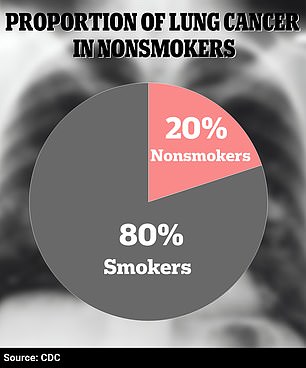The FIVE little-known signs of lung cancer nonsmokers should know – as Big Bang Theory’s Kate Micucci reveals diagnosis, despite never touching a cigarette
Losing breath, changes in the shape of the nails, fainting, eye problems, weight loss and being out of breath are all lesser-known signs of lung cancer that non-smokers could miss, according to specialists.
Experts have warned that those who have never smoked too often pay little attention to warning signs because they assume they are immune to the condition, which is the biggest cancer killer.
But according to Dr. Jorge Gomez, medical director of Mount Sinai Hospital's Solid Tumor Oncology Unit, lung cancer in nonsmokers is “actually much more common than people realize.”
In fact, according to the CDC, one in five lung cancer cases occurs in nonsmokers.
This week, actor and star of The Big Bang Theory Kate Micucci, 43, shocked fans when she revealed her recent lung cancer diagnosis – despite never having smoked.
The mother-of-one, who is known for her role as Lucy on the CBS sitcom, told the world about her illness via TikTok and announced that she was currently recovering from surgery.
Persistent coughing, shortness of breath and fainting can all be symptoms of lung cancer, according to Cancer Research
“They caught it very early,” she said. “It's really weird because I've never smoked a cigarette in my life, so it was a surprise, you know.”
Recently, a growing number of experts have warned that lung cancer prevention strategies focus too heavily on smokers, leading those who avoid cigarettes to think they are immune and ignore warning signs.
Dr. Deborah Lee, who works in Britain, previously said that since the vast majority of people now do not smoke (88 percent), “we need to change the message and warn everyone that lung cancer is common in non-smokers, and that we all need to be vigilant for the symptoms.”
Now DailyMail.com has identified the little-known symptoms of the disease that are too often overlooked – to help you know when to seek help.
Sometimes there are no symptoms in the early stages of lung cancer, experts say.
But more often than not there are subtle signs that are mistaken for something else.
For example, nails that look wider or swollen could be a signal of lung cancer, according to Cancer Research UK, Britain's largest cancer charity.

According to the CDC, up to one in five cases of lung cancer occur in nonsmokers
This symptom is called clubbing. The nails may appear to 'float' rather than stick to the nail bed and form a sharper angle with the cuticle.
Clubbing can also cause the end of the finger to look large and red and the nail to curve downward so that it resembles the round part of an upside-down spoon.
This is caused by hypertrophic pulmonary osteoarthropathy (HPOA) – a condition that causes inflammation in the bones and joints and affects some people with lung cancer.
Tumors in the lungs release specific substances that send signals to the immune system, causing the inflammation.
However, not everyone who has lung cancer will develop this symptom. But for some, it may be their only symptom.
Seizures, dizziness and fainting can also be signs of lung cancer, due to hormones released by tumors, says Cancer Research UK.
Although rare, some lung cancer patients develop a condition called paraneoplastic syndrome in addition to their cancer.
The condition – which can also occur with other cancers – is caused by tumors that release hormones into the bloodstream that cause the body's organs and systems to behave abnormally.
This can lead to symptoms that appear unrelated to lung cancer. These include headache, vomiting, confusion, feeling tired, muscle weakness, seizures, fainting, dizziness and constipation.
One type of lung cancer, called Pancoast tumor, which grows in the upper part of the lung and accounts for less than five percent of lung cancer cases, can cause one eyelid to droop, as well as shrunken pupils.
According to Cancer Research, it can also stop sweating on one side of the face.
About 60 percent of people with lung cancer also have significant weight loss at the time of their diagnosis, according to Cancer Research.

The Big Bang Theory star Kate Micucci has revealed she has lung cancer
This may be because lung cancer causes a loss of appetite.
However, some people lose weight even when they eat normally.
This is called cachexia, where your body doesn't absorb all the fat, protein, and carbohydrates from your food and burns calories faster than normal.
Scientists say cancer releases chemicals into the blood that contribute to fat and muscle loss.
It is not uncommon to feel out of breath when you go for a run or climb a lot of stairs.
But if this continues for months, it could be a sign of something more sinister.
Doctors say this is especially concerning if it's accompanied by a cough that lasts longer than eight weeks, according to VeryWell Health.
Other less subtle signs include coughing up blood and pain in the shoulder or chest when coughing.

The 43-year-old actress, who played Raj's (Kunal Nayyar) love interest Lucy on the show in eight episodes between 2013 and 2017, took to TikTok on Saturday to document her recovery after a successful surgery to remove the disease.
Lung cancer is the leading cause of cancer deaths in the US.
A recent report from the American Cancer Society shows that young women are more likely to develop lung cancer than men.
Men were almost twice as likely as women to develop the disease in the 1980s, due to higher rates of smoking and higher workplace exposure to substances such as asbestos.
But with declining cigarette use and safety regulations, the pattern has reversed, with young and middle-aged women now more likely to be diagnosed with the disease than men because they are slower to quit smoking.
As for non-smokers, vaping and exposure to second-hand smoke, radon gas and asbestos can increase your risk of lung cancer.
Dr. Richard Wender, chief cancer officer at the American Cancer Society, previously said: 'Associating lung cancer with smoking has created a stigma for far too many people. Every year, tens of thousands of people who have never smoked develop lung cancer.
'No one, neither someone who smokes nor someone who has never smoked, should be embarrassed by a cancer diagnosis or, worse, experience a delay in diagnosis.'
Vaping releases all kinds of chemicals into the lungs, which can become trapped there.
Since e-cigarettes have only become popular relatively recently, their long-term health effects are not yet known.
But many e-cigarettes contain deadly chemicals that have previously been linked to a higher risk of lung cancer, such as formaldehyde.
Exposure to radon gas is also a risk factor and is the second leading cause of lung cancer. Radon is produced by the natural breakdown of uranium in soil, rocks and water, which eventually becomes part of the air.
Dangerous levels can build up in any building, including homes.
About 30 percent of lung cancer deaths in nonsmokers have been linked to radon exposure.
Nearly one in fifteen homes in America has too much radon.
Exposure to asbestos, for example in the workplace, can also increase the risk of developing cancer.
Although asbestos is no longer used, it was used extensively in building materials and insulation between 1920 and 1970, meaning workers such as construction workers and firefighters may have been exposed to it over the years.
Although the disease cannot be controlled, a family history of the disease can also increase a person's chance of developing lung cancer.
Researchers have found that only about seven percent of these non-smokers with lung cancer at birth have mutations that increase the risk of cancer – either hereditary or randomly acquired.
Overall, however, the risk is still low, as only about eight percent of lung cancers run in families.
Lung cancer is detected using a low-dose computed tomography scan (CT scan).
One in six people will be diagnosed with lung cancer during their lifetime, and more than 127,000 lives are lost each year.
